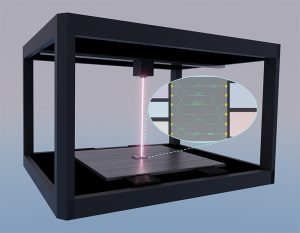By Wayne Gillam | UW ECE News

A research team led by UW ECE and Physics Professor Mo Li has invented a new way to print and reconfigure photonic integrated circuits (microchips) using a speedy, low-cost device about the size of a conventional desktop laser printer. This device could enable students and researchers to bypass expensive nanofabrication facilities and produce photonic integrated circuits almost anywhere. The technology also has possible industrial applications. Illustration by Haoquin Deng | UW ECE
Photonic integrated circuits are an important, next-wave technology. These sophisticated microchips hold the potential to substantially decrease costs and increase speed and efficiency for electronic devices across a wide range of application areas, including automotive technology, communications, healthcare, data storage, and computing for artificial intelligence. Photonic circuits use photons, fundamental particles of light, to move, store, and access information in much the same way that conventional electronic circuits use electrons for this purpose. Photonic chips are already in use today in advanced fiber-optic communication systems, and they are being developed for implementation in a broad spectrum of near-future technologies, including light detection and ranging, or LiDAR, for autonomous vehicles; light-based sensors for medical devices; 5G and 6G communication networks; and optical and quantum computing.
Given the broad range of existing and future uses for photonic integrated circuits, access to equipment that can fabricate chip designs for study, research and industrial applications is also important. However, today’s nanofabrication facilities cost millions of dollars to construct and are well beyond the reach of many colleges, universities, and research labs. For those who can access a nanofabrication facility, at least a day must be reserved for the exacting and time-consuming lithographic process used to make these microchips. On top of that, if an error is made in design, or if the chip doesn’t work properly for some other reason, the faulty circuit must be discarded, the design adjusted, and a new chip fabricated. This often results in days or even weeks spent in the cleanroom.
But now, as described in a new paper in Science Advances, a UW ECE-led research team has devised a way to bypass expensive nanofabrication facilities and produce photonic integrated circuits almost anywhere. The team has developed an innovative method in which these circuits can be written, erased, and modified by a laser writer into a thin film of phase-change material similar to what is used for recordable CDs and DVDs. This new process allows photonic integrated circuits to be constructed and reconfigured in a fraction of the time it would take at a nanofabrication lab.
“Using our method, photonic circuits that previously had to be fabricated in expensive and hard-to-access facilities now can be printed and reconfigured in labs, classrooms, and even garage workshops…” — UW ECE and Physics Professor Mo Li
The multi-university team was led by UW ECE and Physics Professor Mo Li, who is the Department’s associate chair for research, a member of the Institute for Nano-Engineered Systems and the senior author of the paper.
“Photonics technology is on the horizon; therefore, we need to train or educate our students in this field. But for students to study and have hands-on experience with photonic circuits, currently, they need access to a multimillion-dollar facility,” Li said. “This new technology addresses that problem. Using our method, photonic circuits that previously had to be fabricated in expensive and hard-to-access facilities now can be printed and reconfigured in labs, classrooms, and even garage workshops, by a speedy, low-cost device about the size of a conventional desktop laser printer.”
Benefits for students, researchers and industry

From left to right: UW ECE and Physics Professor Mo Li, UW ECE graduate student Changming Fu, UW ECE graduate student Haoqin Deng. Photo of Mo Li by Ryan Hoover | UW ECE
Students aren’t the only ones who stand to benefit from this new way of creating photonic integrated circuits. For researchers, this advance will enable a much quicker turnaround time for prototyping and testing out a new idea before booking valuable time in a nanofabrication facility. And for industrial applications, a big advantage of this method for producing photonic integrated circuits is reconfigurability. For example, companies could possibly use this technology to create reconfigurable optical connections in data centers, especially in systems that support artificial intelligence and machine learning, which would lead to cost savings and production efficiencies.
Li’s research team included UW ECE graduate student Changming Wu, who is lead author of the paper, and, along with Li, came up with the idea for this novel way of building photonic integrated circuits. UW ECE graduate student Haoqin Deng also contributed to the effort. Their work is the latest result of a six-year line of research at the UW that includes advances in optical computing. It is also a continuation of a productive collaboration with Professors Ichiro Takeuchi and Carlos A. Ríos Ocampo and their students at the University of Maryland. The work was funded by the Office of Naval Research and the National Science Foundation.
“Being able to write a whole photonic circuit using only one single step, without a complicated fabrication process, is really exciting. And the fact that we can make any modification to any part of the circuit in our own lab and rewrite and redo it is amazing,” Wu said. “It’s a matter of minutes versus a full, day-long process. It’s a huge relief to be able to finish the whole fabrication process within a few minutes instead of what often is several days or even a week.”
Improving performance, building a commercial device
The method the team developed has been proven to work, but it is still an early-stage concept. However, Li has filed a provisional patent application, and he has plans in progress to build a desktop laser writer for photonic integrated circuits. This printer could be sold at an affordable price and distributed widely to research labs and educational institutions around the world. He is also engaging with industry leaders to promote possible applications of this new technology in programmable photonic chips and reconfigurable optical networks.
This laser printer for photonic chips will use a staging system that will move the substrate in a much more precise manner than in a traditional desktop printer. The team will be seeking ways to optimize its performance as they build a prototype. They also will be working on reducing optical loss in the phase-change material they are using through further research in material science and laser writing techniques. This will enable the printer to produce even more detailed and sophisticated circuits than what is currently possible.
Li said that he and his research team were very excited about what lay ahead.
“This technology can create the photonic circuitry you want, but it also can be added onto already-existing electronic circuitry. And because it is reconfigurable and reusable, it just opens many possibilities for students, researchers, and industry,” Li said. “What’s most exciting to me is that we’ll potentially have a huge impact on the field of photonics in disseminating this new tool and technology to the broader research community.”
For more information about the research described in this article, read “Freeform direct-write and rewritable photonic integrated circuits in phase-change thin films” in Science Advances, or contact Professor Mo Li.

